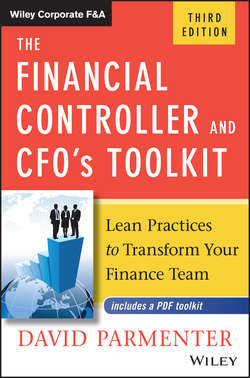Читать книгу The Financial Controller and CFO's Toolkit - Parmenter David - Страница 17
На сайте Литреса книга снята с продажи.
Part I
Change – Why the Need and How to Lead
Chapter 2
Leading and Selling the Change
JOHN KOTTER
ОглавлениеIn 1996, John Kotter published Leading Change,13 which quickly became the seminal work in the field of change management. He pointed out that effecting change – real, transformative change – is hard. Kotter proposed an eight-stage process for creating major change, a clear map to follow when persuading an organization to move. I will discuss each Kotter stage while at the same time embedding Saffron & Logan and Harry Mills' thinking. If you follow these stages, you will increase the chances of change projects many fold.
Establish a sense of urgency– Here we need to appeal both to the intellectual and the emotional sides of the executive team. There are two stages. First, ambush the CEO with a compelling elevator pitch so you get to stage two. Second, deliver a masterful sales presentation of around 15 to 20 minutes, aimed at obtaining permission to run a focus group to assess, validate, and scope the proposed initiative.
Create a guiding coalition– In every organization you have oracles, those individuals everyone refers you to when you need something answered (e.g., “You need to talk to Pat”). These oracles exist right across the organization and might hold seemingly unimportant positions. Do not be fooled.
An investment at this stage is paramount. In one case study, an organization held three two-week workshops that were designed to progress their planning tool implementation. Yes, that is six weeks of workshops. The CEO was present for part of each of the workshops and the wisdom from the oracles was channeled by an expert facilitator into a successful blueprint for the project.
No project will ever succeed without a guiding coalition of oracles behind it. In The Three Laws of Performance, Zaffron and Logan point out that when you present the “burning platform” you are aiming for an overwhelming “Hell, no!” response upon asking the question, “Do you want the default future?” The oracles want the alternative future, which you have also articulated.
However, Mills has warned us to be patient, give time for the staff to discuss, think, and mull over the content. In most cases a two day workshop will be more beneficial in giving staff time to let self-persuasion work.
Develop a vision and strategy– In order for the journey to be seen and resources made available, we must master future-based language that is compelling and motivational. As mentioned, Zaffron and Logan have signified the importance of language (the second law) and that it is crucial that you talk using a future-based language (the third law).
Communicate the change vision– Kotter emphasized that it's not likely that you will under-communicate a little bit; you will probably under-communicate a lot, by a factor of 10 to 100 times. This will undermine your initiative, no matter how well planned. During a project, the project leader needs to obtain permission from the CEO to gate crash any gathering in the organization and have a 10-minute slot to outline the project and progress to date. One surefire way to failure is to believe that staff will read your project newsletters and emails.
Empower broad-based action– Early on the need for change and the right to change must be handed over to teams within the organization. Zaffron and Logan concur with this view. Once the invented future is set in the minds of the organization's staff, the staff will march toward this future. All the great writers have emphasized that some chaos is good, so let teams embrace the project in their own way.
Generate quick wins– Obvious to us all but frequently missed. Always remember that senior management is, on occasion, inflicted by attention deficit disorder. Progress in a methodical and introverted way at your peril. We need easy wins, celebrated extrovertly, and we need to ensure we set up the CEO to score the easy goals.
Consolidate gains and produce more change– This is the flywheel affect so well put by Jim Collins in his books, Built to Last14 and Good to Great.15 When the staff are working in unison the flywheel of change will turn quicker and quicker. This was very evident in the planning tool implementation case study featured in Chapter 4.
Anchor new approaches in the culture– Make heroes of the change agents, make sure their values are embedded in the corporate values, and now ensure you weed out those in management who have not embraced the change and who, over time, will be dowsing the fire at night when nobody is looking.
13
John Kotter, “Leading Change,” Harvard Business Review Press (2012).
14
Jim Collins, Jerry Porras, Built to Last: Successful Habits of Visionary Companies (New York: Harper Business Essentials, 2004).
15
Jim Collins, Good to Great: Why Some Companies Make the Leap…And Others Don't (New York: HarperBusiness, 2001).
